Digital
Why OpenAI is hiring 100 ex-bankers: Inside the ChatGPT-maker's secret project to automate Wall Street's grunt work

As the new GST structure with three slabs—5%, 18%, and 40%—comes into effect from September 22, the Centre has directed consumer product companies to revise the retail sale price (MRP) on unsold packaged goods. The revised MRPs must be displayed through stamping, stickers, or online printing.
According to media reports, consumer goods firms have also been instructed to mention the original MRP alongside the revised one to avoid overwriting on packets. In addition, they must release advertisements and notify dealers about price revisions following the GST overhaul.
In a letter to industry bodies, the Department of Consumer Affairs urged all manufacturers, packers, and importers of pre-packaged products to update MRPs on inventory manufactured, packed, or imported before the new tax slabs take effect.
The ministry has further asked companies to publish two print advertisements and inform Legal Metrology Departments about the revised MRPs.
The display of maximum retail price (‘MRP’) on pre-packaged commodities is governed by the Legal Metrology Act, 2009, and the Legal Metrology (Packaged Commodities) Rules, 2011.
At its 56th meeting last week, the GST Council reduced the structure from four slabs (5%, 12%, 18%, and 28%) to two main rates--5% (merit rate) and 18% (standard rate), along with a 40% special rate for sin and luxury goods.
The food-processing sector has emerged as a major beneficiary of this rationalisation, with most products moving to the 5% slab. Consumers are expected to benefit from lower food prices, making staples more affordable. This, in turn, could boost consumer demand, with FMCG and packaged food businesses likely to see an uptick in sales, according to the Ministry of Food Processing Industries.
From purpose-driven work and narrative-rich brand films to AI-enabled ideas and creator-led collaborations, the awards reflect the full spectrum of modern creativity.
Read MoreIn a wide-ranging interview with Storyboard18, Sorrell delivers his frankest assessment yet of how the deal will redefine creativity, media, and talent across markets.